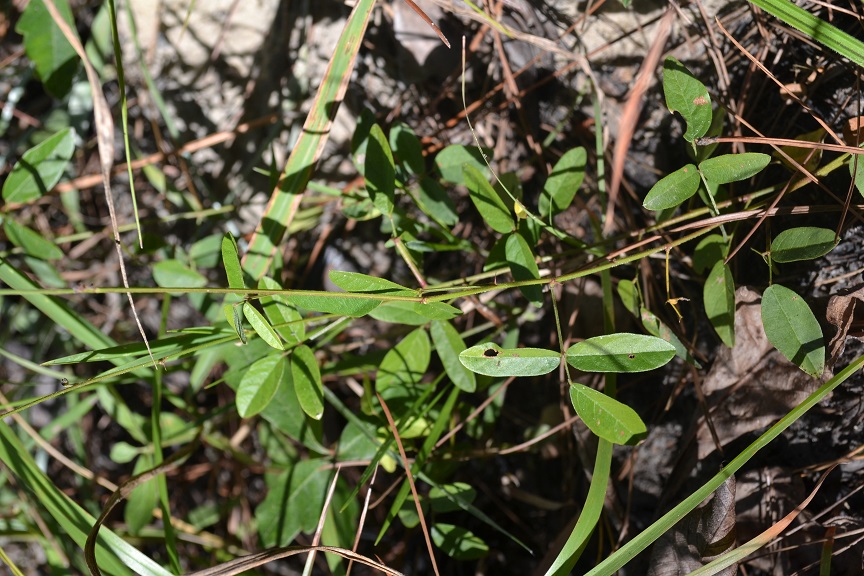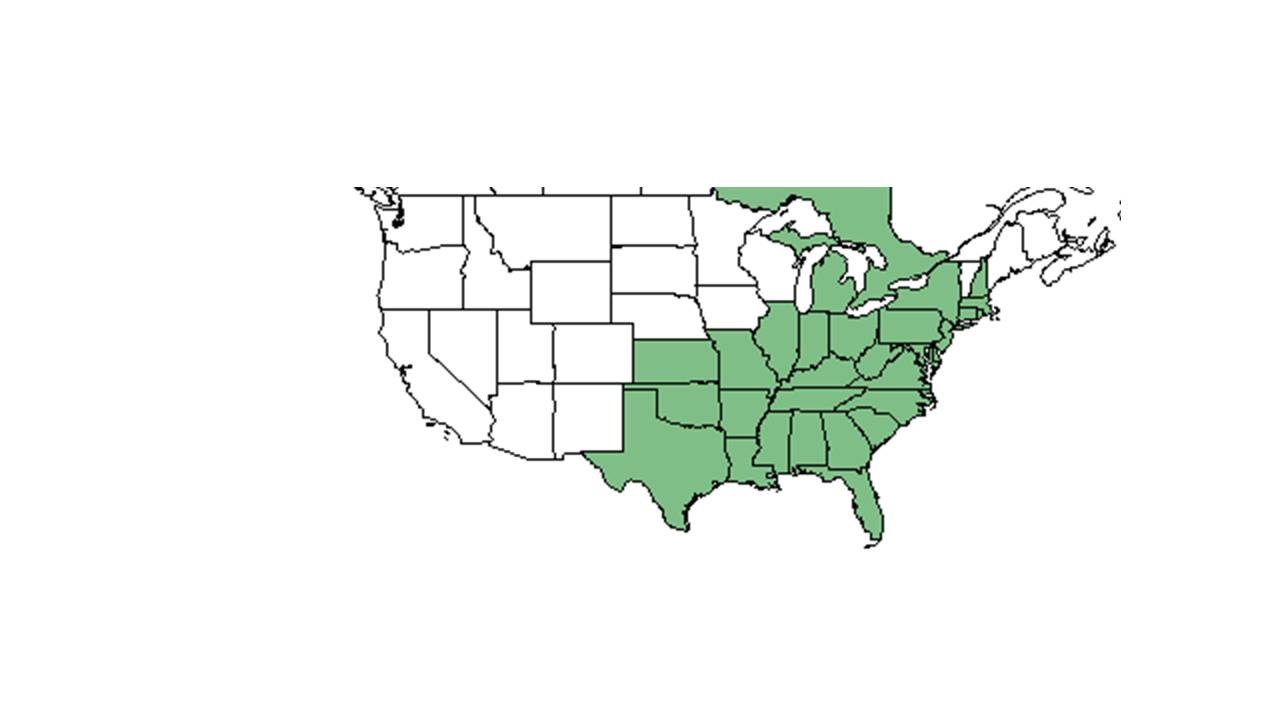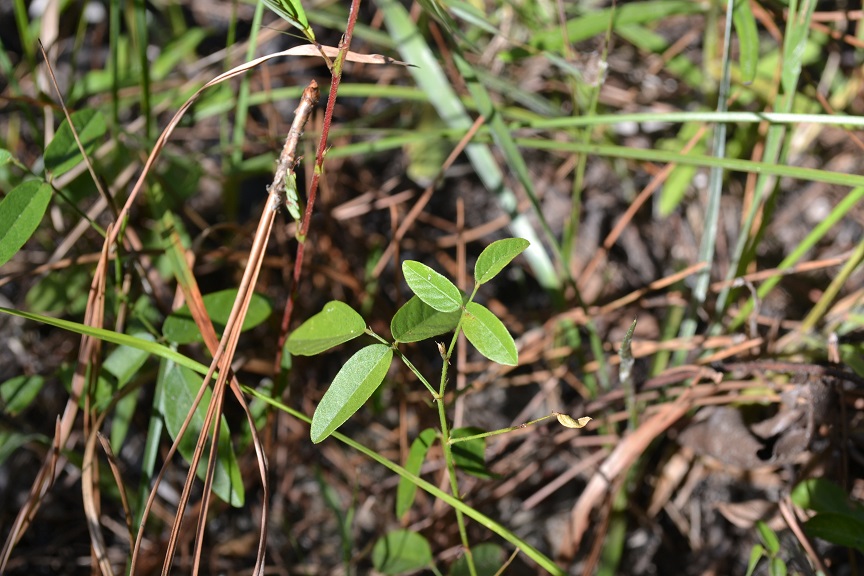Desmodium marilandicum
| Desmodium marilandicum | |
|---|---|

| |
| Photo taken by Kevin Robertson | |
| Scientific classification | |
| Kingdom: | Plantae |
| Division: | Magnoliophyta - Flowering plants |
| Class: | Magnoliopsida – Dicotyledons |
| Order: | Fabales |
| Family: | Fabaceae ⁄ Leguminosae |
| Genus: | Desmodium |
| Species: | D. marilandicum |
| Binomial name | |
| Desmodium marilandicum (L.) DC. | |

| |
| Natural range of Desmodium marilandicum from USDA NRCS Plants Database. | |
Common name: Smooth small-leaf ticktrefoil
Contents
Taxonomic notes
Synonym: Meibomia marilandica (Linnaeus) Kuntze
Description
Generally, for Desmodium genus, they are "annual or perennial herbs, shrubs or small trees. Leaves 1-5 foliolate, pinnately 3-foliolate in ours or rarely the uppermost or lowermost 1-foliolate; leaflets entire, usually stipellate; stipules caduceus to persistent, ovate to subulate, foliaceous to setaceous, often striate. Inflorescence terminal and from the upper axils, paniculate or occasionally racemose; pedicel of each papilionaceous flower subtended by a secondary bract or bractlet, the cluster of 1-few flowers subtended by a primary bract. Calyx slightly to conspicuously 2-lipped, the upper lip scarcely bifid, the lower lip 3-dentate; petals pink, roseate, purple, bluish or white; stamens monadelphous or more commonly diadelphous and then 9 and 1. Legume a stipitate loment, the segments 2-many or rarely solitary, usually flattened and densely uncinated-pubescent, separating into 1-seeded, indehiscent segments." [1]
Specifically, for D. marilandicum species, they are "erect perennial; stems 0.6-1.5 m tall, glabrous or sparsely uncinulate-puberulent and short-pubescent, but never pilose. Terminal leaflets ovate to suborbicular or oblong to elliptic, 1-2.5 (5) cm long, usually 1.6-2.2 as long as wide, both surfaces glabrous to moderately short-pubescent especially on the calyx lobes; petals purplish, 4-6 mm long; stamens diadelphous. Loment of 1-3 weekly obovate segments, each 3.5-5.5 mm long, 3-4 mm broad, slightly convex to almost straight along the upper suture; stipe 1.5-2.5 mm long, equaling or shorter than the calyx and exceeded by the stamina remnants." [1]
Distribution
Ecology
Habitat
It is found in pine-oak-hickory woodlands, open, upland pine, dry ridges, and sandhills. Is found in mostly human disturbed areas such as woodlands bordering the road, clearing in a live-oak woodland, clearing between pineland and field, edge of mixed woods around a campground, sterile hillside, and abandoned fields. Requires semi-shaded to open areas. It associates with areas with loamy sand and clayey soil types[2].
Phenology
It has been observed flowering from August through October; and fruiting from September through November[2].
Seed dispersal
According to Kay Kirkman, a plant ecologist, this species disperses being carried externally by vertebrates. [3]
Fire ecology
It can withstand areas with annual burns and winter burns (FSU Herbarium).
Conservation and Management
Cultivation and restoration
Photo Gallery
References and notes
Florida State University Robert K. Godfrey Herbarium database. URL: http://herbarium.bio.fsu.edu. Last accessed: June 2014. Collectors: Loran C. Anderson, R. K. Godfrey, V. Sullivan, J. Wooten, A. F. Clewell, R. Kral, R. Komarek, T. MacClendon, - Boothes; K. Blum, Norlan C. Henderson, John W. Thieret, H. R. Reed, Delzie Demaree, A. C. Mathews, A. E. Radford, G. W. Parmelee, and H. A. Wahl. States and Counties: Alabama: Cleburne, Franklin, and Russell. Arkansas: Drew. Florida: Jackson and Leon. Georgia: Baker and Decatur. Indiana: Elkhart. Louisiana: Morehouse and Natchitoches. Michigan: Barry. Mississippi: Pearl River. Missouri: Henry. North Carolina: Orange and Surry. Pennsylvania: Venango. Virginia: Montgomery.
- ↑ 1.0 1.1 Radford, Albert E., Harry E. Ahles, and C. Ritchie Bell. Manual of the Vascular Flora of the Carolinas. 1964, 1968. The University of North Carolina Press. 604-10. Print.
- ↑ 2.0 2.1 Florida State University Robert K. Godfrey Herbarium database. URL: http://herbarium.bio.fsu.edu. Last accessed: June 2014. Collectors: Loran C. Anderson, R. K. Godfrey, V. Sullivan, J. Wooten, A. F. Clewell, R. Kral, R. Komarek, T. MacClendon, - Boothes; K. Blum, Norlan C. Henderson, John W. Thieret, H. R. Reed, Delzie Demaree, A. C. Mathews, A. E. Radford, G. W. Parmelee, and H. A. Wahl. States and Counties: Alabama: Cleburne, Franklin, and Russell. Arkansas: Drew. Florida: Jackson and Leon. Georgia: Baker and Decatur. Indiana: Elkhart. Louisiana: Morehouse and Natchitoches. Michigan: Barry. Mississippi: Pearl River. Missouri: Henry. North Carolina: Orange and Surry. Pennsylvania: Venango. Virginia: Montgomery.
- ↑ Kay Kirkman, unpublished data, 2015.
